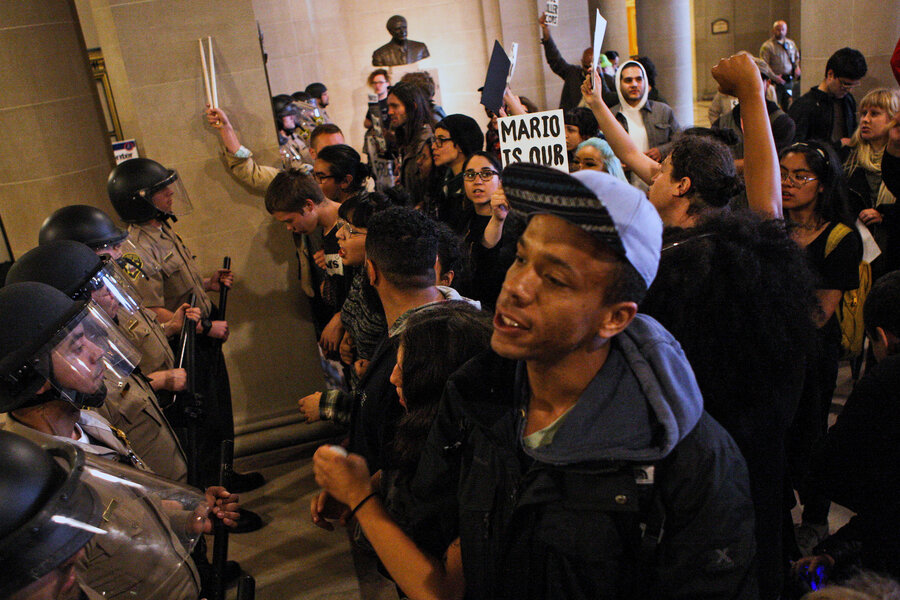What's fueling violent protests over the San Francisco police
Loading...
Protestors stormed into San Francisco's City Hall Friday demanding that the mayor fire the police chief.
The San Francisco Police Department faces protests and public scrutiny following several police shootings and the discovery that some officers had made offensive comments about gays and minorities via text, making the city an example of how police are wrestling to resolve tensions with minority communities.
Protesters overwhelmed city hall after the "Frisco 5" hunger strike – in which protesters of the shootings refuse to eat until the police chief is fired – reached Day 16, CBS San Francisco reported. They had received a call on Thursday from San Francisco Mayor Ed Lee, who said he stood by the continuing reforms of Police Chief Greg Suhr, recognized their right to protest, and hoped the hunger strikers would "take care" of themselves.
But a crowd of around 1,000 demanded to speak with the mayor on Friday, Marco Siler-Gonzales reported for the Bayview. When a representative suggested they speak to the mayor's advisors in his absence, they instead confronted the Board of Supervisors, who said they had no authority to fire the police chief.
“It’s not just the police chief; it’s about the whole department," District 9 Supervisor David Campos told protesters. "I am here to tell you that we want to work with you."
About 25 people were arrested after they refused to leave the building and after San Francisco Sheriff's Department deputies twice ordered them to leave. The deputies clad in helmets and armed with batons pushed the crowd back, the Associated Press reported. A witness video posted on Twitter shows four deputies dragging a man on the floor to tie him with wrist ties.
The San Francisco police department has made several efforts to calm the situation in recent months, including a request for a voluntary Justice Department review. This step is less demanding than the formal civil rights investigations launched against police in Cleveland and Ferguson, Mo., but it also shows effort by the police department itself to make changes from top to bottom, Jessica Mendoza wrote for The Christian Science Monitor.
In January, Chief Suhr announced all police would annually pledge to avoid hate, bigotry, and intolerance and report any instances they encountered, The Monitor reported.
That announcement followed revelations that some police had been exchanging racist and offensive text messages, an incident that lead Suhr to fire eight officers. After police shot a knife-wielding black man in December, Suhr promised to institute mandatory reporting each time a lethal weapon was introduced, as well as new training for "less-than-lethal" police methods.
In April, however, reports implicated five more officers in the text scandal, and officers shot a homeless Latino man they said had a knife, the AP reported. The protests and calls for Suhr's resignation, which had dropped to dull roar, returned with full force.
That officers thought they could get away with such behavior reflects poor leadership, Samuel Walker, a retired criminal justice professor from the University of Nebraska at Omaha, told the Associated Press.
"If you have a poorly managed department without standards of accountability, everybody sinks to the bottom," he said.
Despite protesters' insistence that they will continue the hunger strike until Suhr is fired, the mayor continues to back in his reform efforts. Stephen Rickman, who helped with a similar voluntary review in Las Vegas as part of CNA Institute for Public Research, a nonprofit research firm, said this kind of police buy-in takes time but is worth the wait.
"Departments are much more receptive than ever before,” Mr. Rickman told the Monitor. “In spite of all the background noise, the tensions, this is a good time. Society is beginning to transform itself.”






